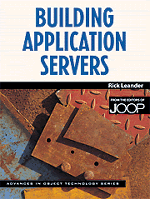Book contents
- Frontmatter
- Contents
- acknowledgements
- Introduction
- PART 1 ARCHITECTURE
- PART 2 DESIGN
- Chapter 3 Designing Application Servers
- Chapter 4 Service Interface Design
- Chapter 5 Designing Business Objects
- Chapter 6 Designing the Persistent Object Layer
- Chapter 7 Integrating Existing Systems and Legacy Software
- PART 3 PROGRAMMING
- Appendix: Setting up a Development Environment
- Index
Chapter 3 - Designing Application Servers
from PART 2 - DESIGN
Published online by Cambridge University Press: 06 July 2010
- Frontmatter
- Contents
- acknowledgements
- Introduction
- PART 1 ARCHITECTURE
- PART 2 DESIGN
- Chapter 3 Designing Application Servers
- Chapter 4 Service Interface Design
- Chapter 5 Designing Business Objects
- Chapter 6 Designing the Persistent Object Layer
- Chapter 7 Integrating Existing Systems and Legacy Software
- PART 3 PROGRAMMING
- Appendix: Setting up a Development Environment
- Index
Summary
The goal of business software design is to create information tools that support the organization's business activities. The software developer has to work closely with the end users and be able to communicate in business language as well as computer language. At the same time, the end users have to become educated to understand the computer's capabilities and limitations. Business needs change quickly, so an effective design methodology must be flexible and adapt easily to changing business requirements.
N-tier computing complicates the design process even more. While traditional two-tiered client/server emphasized applications and user interfaces, n-tier design requires both application-oriented software design as well as process-oriented business object design. The pressure is on to produce applications in shorter timeframes while creating more robust, reusable business objects. The days of the coding cowboy are over.
Fortunately, there are methodologies and tools to support these requirements. The joint application development GAD) team approach brings software developers and end users together to design software jointly. Iterative, incremental development provides shorter design and programming cycles to ensure that the project stays on track and meets the end user's needs. The Unified Modeling Language (UML) can be used by both software developers and end users to communicate design ideas. Computer-aided software engineering (CASE) tools such as Rational Rose can streamline this process by creating UML diagrams, generate skeleton code and then update the UML models as the design progresses.
- Type
- Chapter
- Information
- Building Application Servers , pp. 43 - 64Publisher: Cambridge University PressPrint publication year: 2000



